Have you ever tried to play an out of tune guitar? Or worse: had to listen to someone playing an out of tune guitar? Even the best guitarist in the world would sound terrible if their guitar isn’t in tune!
For this reason, knowing how to tune a guitar is an essential skill for any guitar player.
When I first started playing, I’d often skip tuning my guitar – eager to just get on and play instead. It wasn’t until my family kindly pulled me aside to inform me that “something didn’t sound right” that I put more thought into tuning! Nowadays, I check my guitar’s tuning every time I sit down to play.
In this guide, I’ll show you how to tune an electric guitar using a range of different types of guitar tuners that I own, with a detailed description for each one. I’ll also share my thoughts and personal experiences on each type, to help you to decide which is best for you.
Affiliate disclaimer: This page contains affiliate links for products that I’ve tried and tested. As an Amazon Associate I earn from qualifying purchases at no additional cost to you. Learn more here.
Getting started with guitar tuning
Your guitar’s tuning is controlled by the tuning pegs (sometimes called “machine heads”, or simply “tuners”) on top of the headstock.
Twisting the tuning pegs either tightens or loosens the string depending on the direction you turn it. Tightening the string makes it “sharper” (higher pitched), and loosening the string makes it “flatter” (lower pitched).
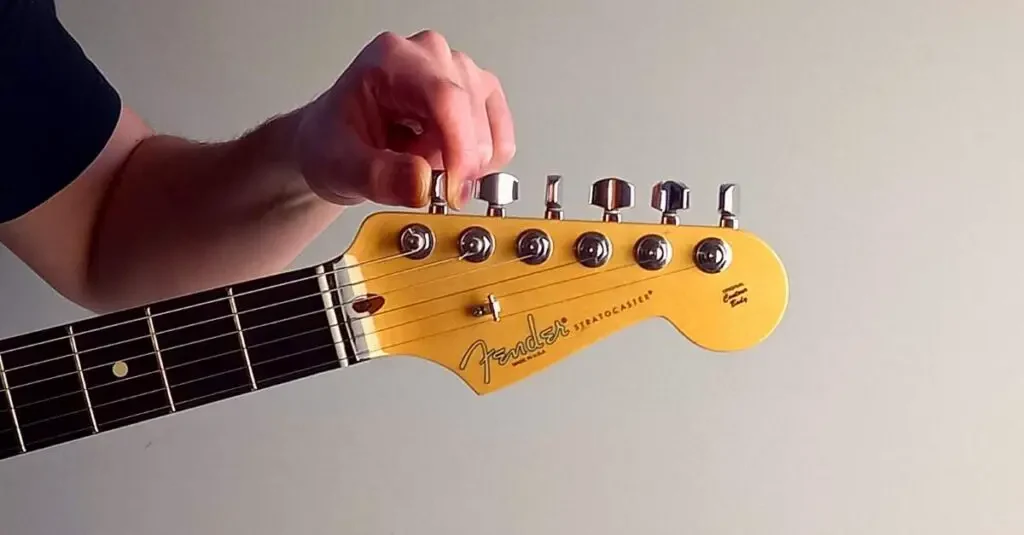
When tuning your guitar, often with the aid of a guitar tuner, you’ll turn these tuning pegs until each string is at the correct pitch.
But, there’s a lot of different factors that can affect your guitar’s tuning: how often you play, how old your strings are… even down to how you store your guitar!
All of these factors can cause your guitar to slip out of tune over time. So, it’s important to make sure that you tune your guitar every time you pick it up to play.
Pro tip: If your guitar won’t stay in tune, then it might be time to change your guitar strings.
What are electric guitars tuned to?
There’s lots of different guitar tunings out there, but the most common is “E standard” (also simply called “standard tuning”). This means the strings are tuned, from the thickest to thinnest, to E-A-D-G-B-E.
An easy way to remember this is the mnemonic “Eddie Ate Dynamite, Good Bye Eddie”. That’s the one I learned when I was younger – it always stuck with me because it’s silly, fun, and easy to remember!
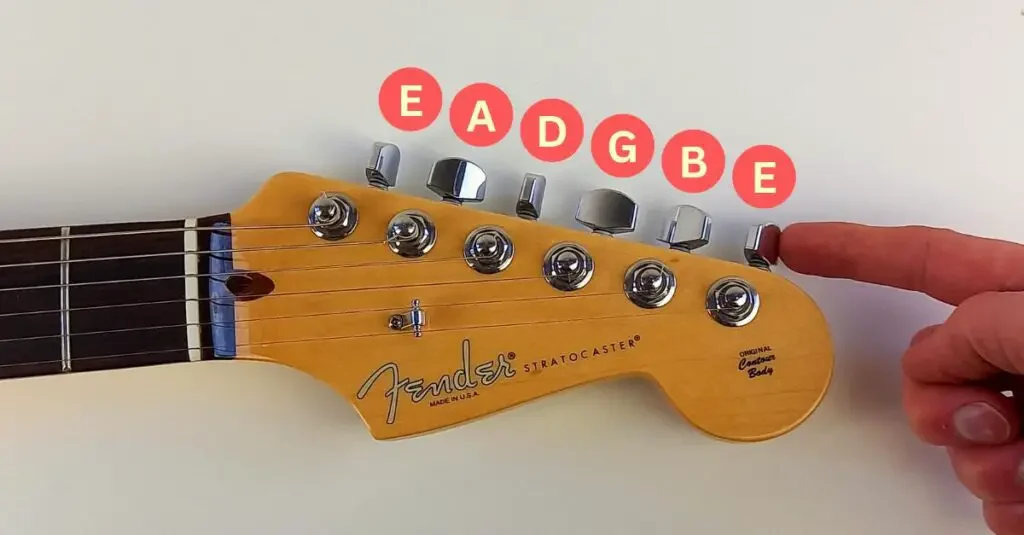
If you’re just getting started with learning guitar, then I recommend keeping your guitar in standard tuning until you get to grips with the basics. Most popular songs are written in standard tuning, so you’ll have plenty of songs to learn.
But, if you have the calling to drop your tuning and chug out some heavy metal riffs, or just the urge to try something a little different, then there’s plenty of alternate guitar tunings to choose from.
How to tune an electric guitar with a tuner
Using a guitar tuner is by far the easiest and most reliable way to tune your guitar. Each tuner has a built-in display that shows you the note that your guitar string is closest in pitch to, and how close it is to that pitch.
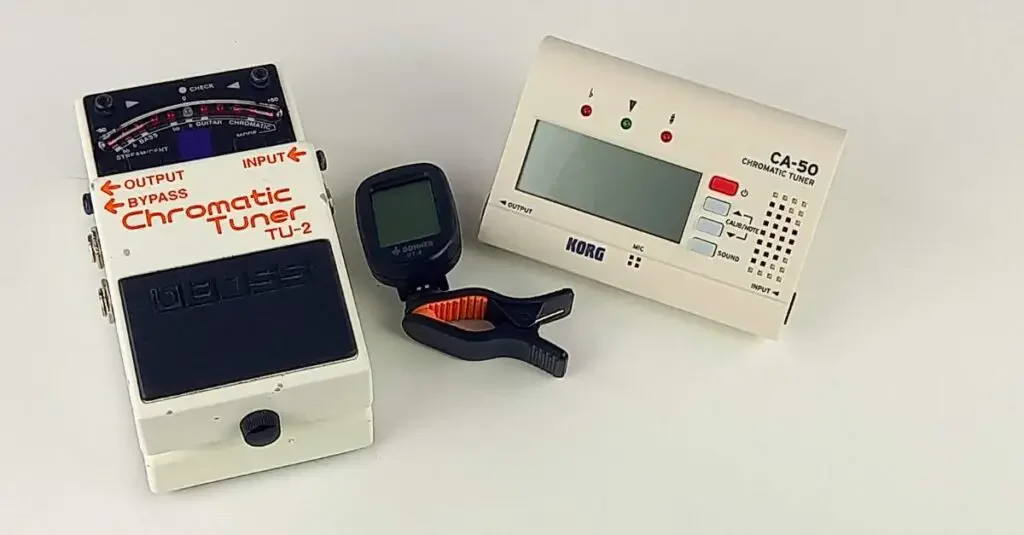
In most cases (at least, with every tuner I’ve ever seen!) the pitch of the string is shown in the middle with some kind of indicator as to whether you’re flat or sharp.
If your string is sharp, the indicator will be to the right side of the center, and if you’re flat it’ll be to the left side. The further away the indicator is away from the center, the sharper or flatter your string is!
Once the string is tuned to pitch, the indicator will be in the center, pointing directly at the note. A lot of the tuners I’ve owned light up as well, to make it even clearer!
There’s a few different types of guitar tuners available for tuning a guitar, depending on what your preferences are:
- Tuning pedals: These are dedicated guitar pedals that take a direct signal from your guitar and show you how in-tune it is. In my opinion, a tuning pedal is the gold standard for tuning your guitar and is essential for any guitarist that’s looking to play live.
- Handheld tuners: Handheld tuners are affordable, pocket-sized devices that are great for beginners. They can take either a direct signal from your guitar, or pick up the sound using a built-in microphone.
- Clip-on tuners: Clip-on tuners attach to your guitar’s headstock and use the vibrations of the guitar string through the neck to show you the tuning.
- Guitar tuning app: Tuning apps use your smartphone’s microphone to tell you how in-tune your strings are. They’re very handy if you don’t have a tuner nearby, and there are even some free tuning apps out there.
Let’s take a look at how to tune your guitar using each one of these tuners.
Using a tuning pedal
Guitar tuning pedals work by taking a direct signal from your guitar and showing how in-tune it is using the built-in display. Most of the time, they also include lights to give you more visual aid – especially as these are usually down on the floor when you use them!
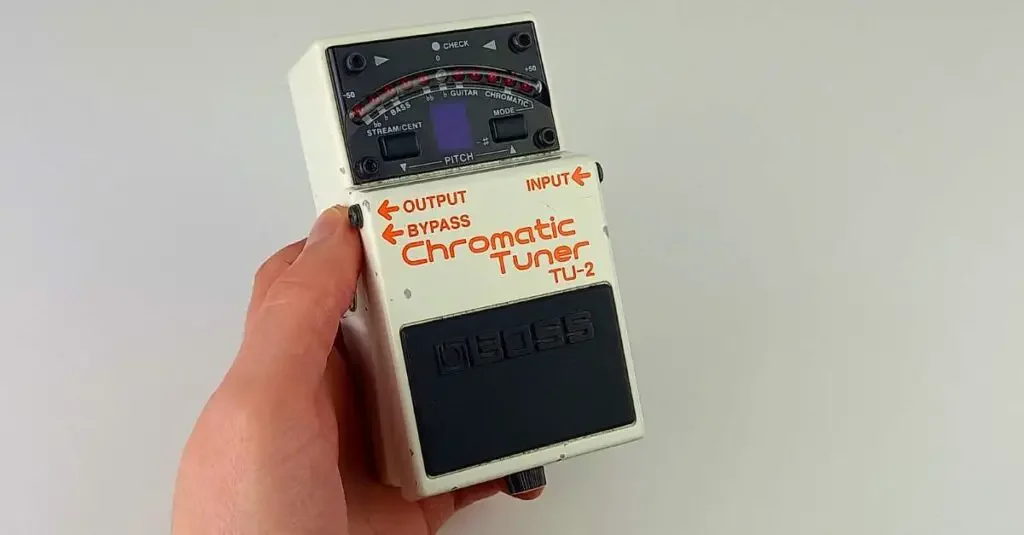
Here’s how to tune your guitar using a guitar tuning pedal:
- Connect your guitar to the tuning pedal using a standard guitar cable
- Turn on the tuning pedal
- Turn the volume knob on your guitar to maximum
- Starting with the low E string, pluck the string and read the display on the tuner
- Turn the machine head on the headstock to adjust the pitch until it is correct. If the note is sharp, tune the string down. If the note is flat, tune the string up.
- Repeat for each string until all strings are in-tune
In my opinion, using a tuning pedal is the best way to tune your guitar as it takes a direct signal from your guitar, while also allowing your signal to flow through to other guitar pedals or an amp.
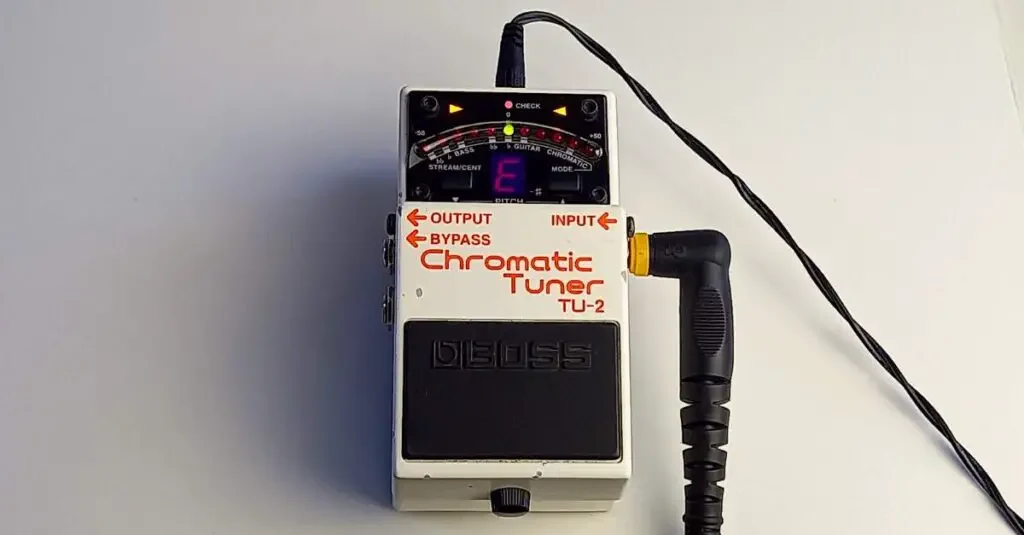
The drawback is that if you’re only practicing at home, it can be a bit of a pain to set up the pedal every time you want to play – at least, that’s what I’ve found!
But, if you’re serious about playing guitar, especially performing live, I strongly recommend picking up a dedicated tuning pedal.
I’ve used my Boss TU-2 pedal for around 10 years now, and it’s served me great. Though nowadays, it’s been surpassed by the newer Boss TU-3. You can check out the Boss TU-3 here on Amazon.
As a final note, some tuning pedals will mute your guitar’s signal if it’s on, to help you tune quietly on-stage. So, be sure to turn it off once you’ve finished!
Using a handheld tuner
Handheld tuners are small pocket-sized tuners that can take a direct signal from your guitar, or pick up the sound using a built-in microphone.
They’re a great choice for beginners as they’re very affordable (more-so than a tuning pedal) and they’re quick and easy to use.
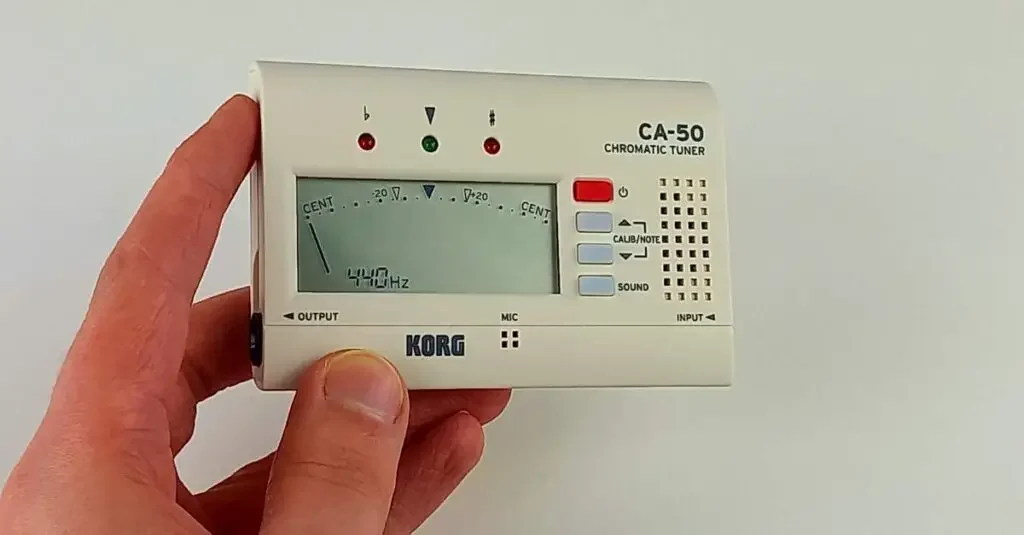
Here’s how to tune your guitar using a handheld tuner:
- Connect your guitar to your handheld tuner using a standard guitar cable
- Turn on the tuner
- Turn the volume knob on your guitar to maximum
- Starting with the low E string, pluck the string and read the display on the tuner
- Turn the machine head on the headstock to adjust the pitch until it is correct. If the note is sharp, tune the string down. If the note is flat, tune the string up.
- Repeat for each string until all strings are in-tune
However, most of these tuners have a built-in microphone. In this case, it’s possible to tune without needing a guitar cable. Simply make sure you’re in a quiet space, power on the tuner, pluck your string, and adjust the tuning machine heads as described above.
But, I’ve found that plugging the guitar into the tuner is consistently more accurate than using the built-in microphone!
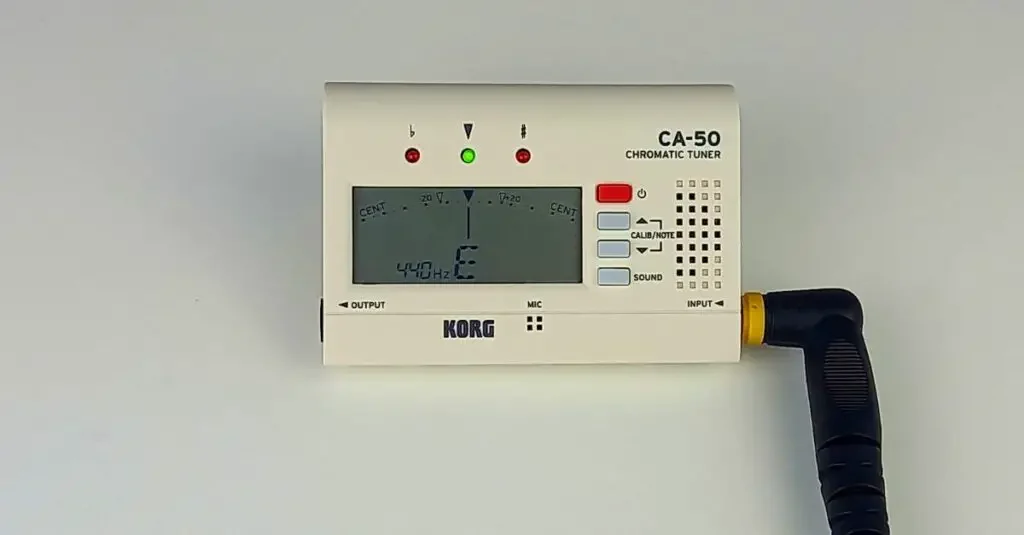
If you’re looking to get started with a handheld tuner, I recommend picking up a Korg CA-50. It’s the one I use, and I’ve had nothing but good experiences with it.
The tuning is accurate (it’s inline with my Boss pedal), it’s simple to use, and it’s much cheaper than a pedal. You can check out the latest price here on Amazon.
Using a clip-on tuner
As the name suggests, clip-on tuners work by clipping onto your guitar’s headstock. Once on, it picks up the vibrations from your guitar without you having to plug it in.
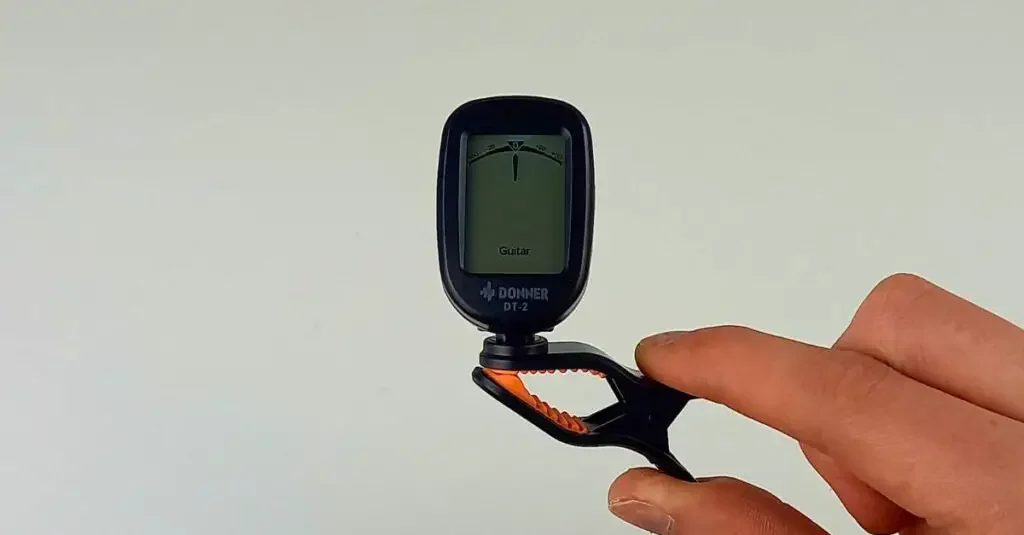
The biggest benefit to these tuners is that they don’t rely on a microphone, which makes them great for tuning in loud settings like playing live.
Here’s how to tune your guitar using a clip-on tuner:
- Clip the tuner onto the tip of your guitar’s headstock
- Turn on the tuner
- Angle the display so that you can see it clearly
- Starting with the low E string, pluck the string and read the display on the tuner
- Turn the machine head on the headstock to adjust the pitch until it is correct. If the note is sharp, tune the string down. If the note is flat, tune the string up.
- Repeat for each string until your guitar is in tune
I was late to the “clip-on tuner party”, as I bought a tuning pedal quite early. But, I have to say these are really useful little devices. I’d say they have a slight edge over the handheld tuners.
If you’re like me and are always in a rush to just get playing, you can clip one of these to your guitar and get tuned up in seconds. It really is much easier than messing around with cables several times a day.
Again, I don’t think these fully replace the need for a tuning pedal – but they’re great for convenience and speed!
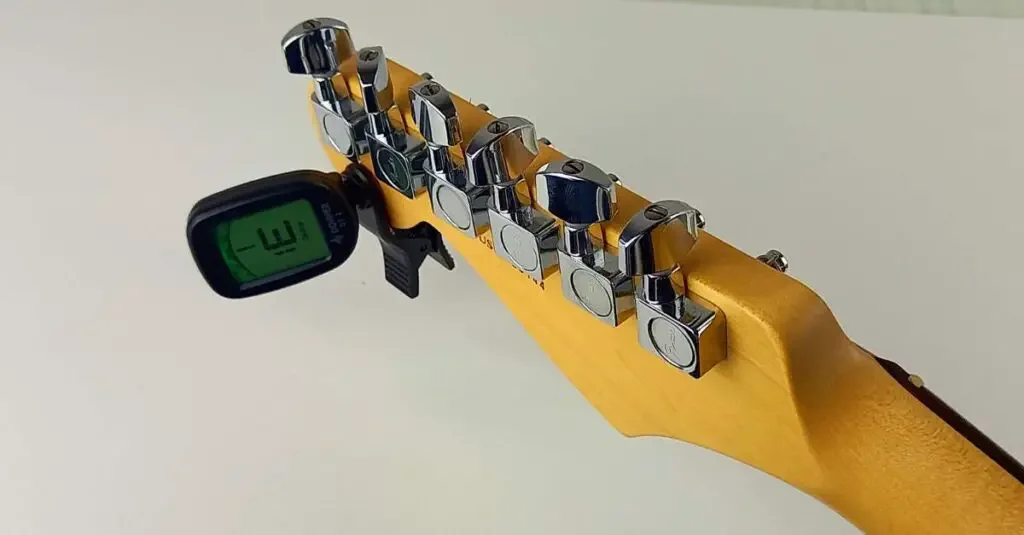
I use the Donner DT-2. It’s actually become my go-to because of convenience. It doesn’t fully replace my guitar pedal tuner, as that’s definitely better for performing live and in the studio, but it’s definitely earned its place in my day-to-day routine! You can check it out here on Amazon.
Finally, as handy tip – remember to take it off your guitar when you’ve finished playing. I’ve “lost” mine many times only to find it exactly where I left it – on my guitar’s headstock!
Using a guitar tuning app
Nowadays, if you have a smartphone then you have access to a guitar tuner. Guitar tuning apps are a really useful piece of tech to have for any guitarist.
If your normal tuner has run out of battery, or you just can’t find it, a tuning app is really handy to have in a pinch!
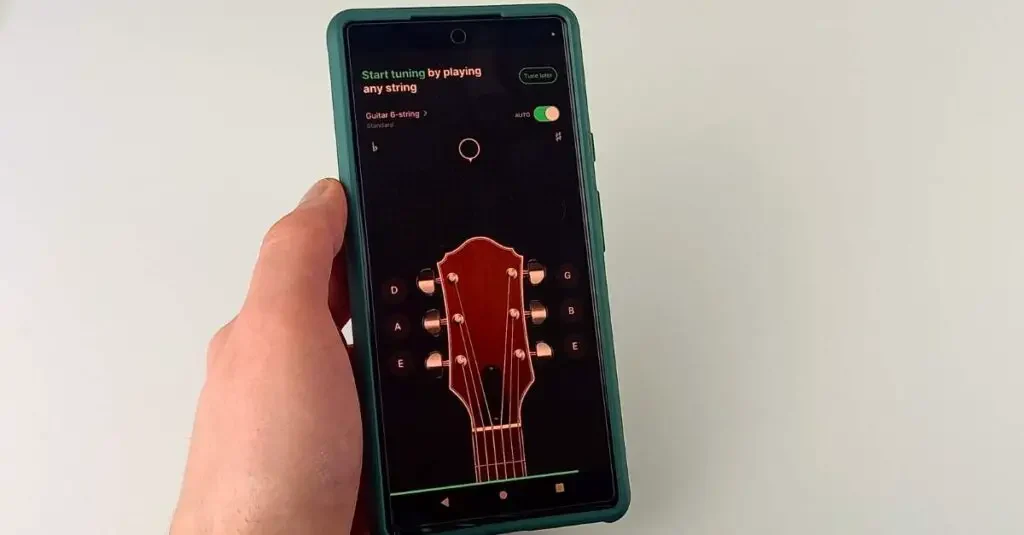
Here’s how to tune your guitar using a guitar tuning app:
- Find a quiet space to reduce interference
- Open the guitar tuner app
- Starting with the low E string, pluck the string and read the display on the tuner
- Turn the machine head on the headstock to adjust the pitch until it is correct. If the note is sharp, tune the string down. If the note is flat, tune the string up.
- Repeat for each string until your guitar is in tune
Like other microphone-based tuners, you’ll need to make sure that there’s no interference around you. So, you won’t be using this on stage to tune between songs!
Having said that, I’ve found that they’re fairly accurate and easy to use.
I see guitar tuning apps as a great back-up tuner to have! I keep a guitar tuning app loaded on my phone, even though I don’t use it all that often. Personally, I use the GuitarTuna app, though I find that the free version can be a bit awkward to use with the ads.
How to tune an electric guitar without a tuner
If you don’t have a guitar tuner available, then you can tune your guitar by ear. Tuning by ear means tuning your guitar to a played note. This can either be from an online based tone-generator or by using your guitar itself!
But, be aware that tuning by ear is often less accurate than using a tuner – although it is a useful skill to have.
Tuning by ear
Tuning your guitar by ear can be tricky for beginners who are just getting to grips with pitch.
But, tuning your guitar by ear doesn’t mean you need perfect pitch. You don’t have to tune the note from memory (even after 20 years of playing I can’t do that!).
To tune your guitar using your ear, you’ll need a reference sound. This could be a piano, another in-tune guitar, or (most commonly) an online source, like the Fender Guitar Tuner.
Here’s how to tune your guitar by ear:
- Play the reference tone for the string you’re tuning
- Starting with the low E string, pluck the string and listen to whether it sounds in pitch with the reference tone
- Turn the machine head on the headstock to adjust the pitch until it is correct. If the note is sharp, tune the string down. If the note is flat, tune the string up.
- Repeat for each string until your guitar is in tune
In my experience, tuning your guitar by ear is one of least accurate ways to tune, especially if you’re new to guitar. But, it is a very useful skill to have and develop. It’ll at least help you get in a “ballpark” tuning, which is enough if you just want to get on and play.
As a tip, if you’re not sure whether your guitar string is sharper or flatter than the reference pitch – just tune your guitar down. You can then slowly tune it up to the correct pitch!
Tuning using your guitar
Using your guitar to tune itself is a useful trick for quickly making your guitar in-tune with itself. So, even if you’re not in perfect tuning, at least all your strings are tuned relative to each other.
To do this, you’re going to play a note on a string and use it to tune the string directly below.
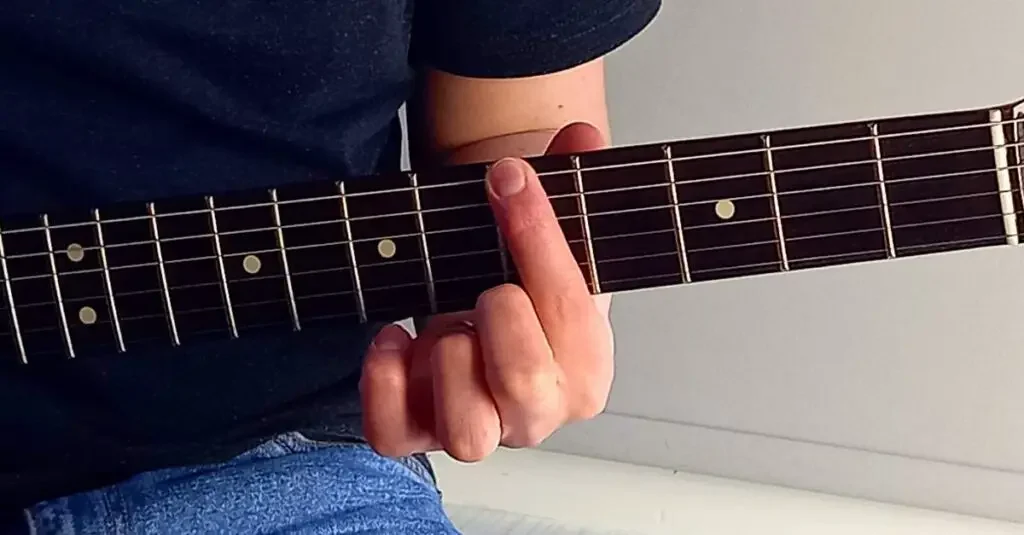
Here’s how to tune your guitar using the guitar:
- Play the 5th fret of the low E string to tune the A string
- Play the 5th fret of the A string to tune the D string
- Play the 5th fret of the D string to tune the G string
- Play the 4th fret of the G string to tune the B string
- Play the 5th fret of the B string to tune the high E string
As you might have noticed, the overall success of this method depends on how in-tune your low E string is.
I mostly use this technique when I just want to get straight to playing. As long as you’re playing guitar alone then it doesn’t matter if your guitar isn’t in perfect pitch.
It’s also a handy technique for quickly fine tuning your strings if you’ve tuned using a tone generator.
The downside is that you can’t use it if your guitar has a floating bridge setup. Simply put, changing any of the strings’ tunings will change the tuning of every other string! In this case, it’s best to stick with a tuner!
Alternate guitar tunings
E standard is by far the most commonly used guitar tuning, and is definitely the one I’d recommend for beginners. But, if you’re looking for a specific sound, or just want to try something new, there’s plenty of alternate tunings to choose from.
Drop D
Drop D tuning is where you tune the low E string down to D, keeping all the other strings in their E standard tuning.
From low strings to high, Drop D tuning is: D-A-D-G-B-E.
It’s one of the easiest tunings to switch to, as you’re only tuning down one string. It’ll give your guitar a very beefy sound and means you can play power chords with just one finger!
I find it easiest to tune to Drop D by plucking the low E and D strings together, and tuning the E string down until it matches the sound of the D string. However, this won’t work if your guitar has a floating bridge. In that case – you’ll be best off using a guitar tuner.
Eb (E flat)
Sometimes called “half a step down” tuning, Eb (“b” is the musical symbol for flat) is another very common alternate tuning that’s popular in rock and blues. Guitarists like Jimmy Hendrix, Slash, and Stevie Ray Vaughan spent a lot of their time tuned to Eb.
This requires a bit more effort than Drop D, as you’ll have to tune down all of your strings half a step. Again, best to use a tuner for this.
Starting low to high, Eb tuning is: Eb-Ab-Db-Gb-Bb-Eb.
An added benefit of Eb tuning is that it’ll subtly release some tension from your strings, making them feel much easier to bend!
Drop C and Drop B
Drop C and Drop B tunings belong solely in the world of hard rock and heavy metal. Think Slipknot, Rammstein, Disturbed… heavy guitars with a thick, bassy growl.
To tune your guitar to Drop C (think of it like Drop D tuning but a whole step down on each string): C-G-C-F-A-D.
Drop B is tuned down half a step further to: B-Gb-B-E-Ab-Db.
If you do use lower tunings, then you’ll need to use the right guitar strings in order to keep the string tension and stop them from becoming floppy!
Open tuning
Finally, open tuning is a great choice for anyone looking to try out slide guitar or more chordal playing. The principal is simple: the strings are tuned to each note of a chord. So, strumming the open strings sounds like a chord.
I’d recommend starting with open E tuning as it’s closest to standard tuning, so you can quickly tune back if it’s not for you.
From thickest to thinnest strings, open E tuning is: E-B-E-Ab-B-E.
Open tuning is particularly good for slide guitar because it makes it really easy to slide chords and double-stops.
Final thoughts on tuning an electric guitar
Tuning your guitar is an essential skill for guitar players to master – and with the help of guitar tuners it’s incredibly easy!
If you’re just getting started with playing electric guitar, I’d recommend picking up a clip-on tuner. They’re really inexpensive, accurate, and very handy to use!
Once you start to progress, then I’d recommend picking up a tuning pedal – especially if you’re going to be playing live.
And remember: it doesn’t matter how good you are at guitar if it isn’t in tune! So, make sure to tune up before each practice. Your ears (and anyone listening) will thank you.
Related questions

Conor is a music producer, multi-instrumentalist, and all-round enthusiast from the UK with over 15 years of experience. He’s the founder and sole-content creator for the roundtable audio blog and YouTube channel.
